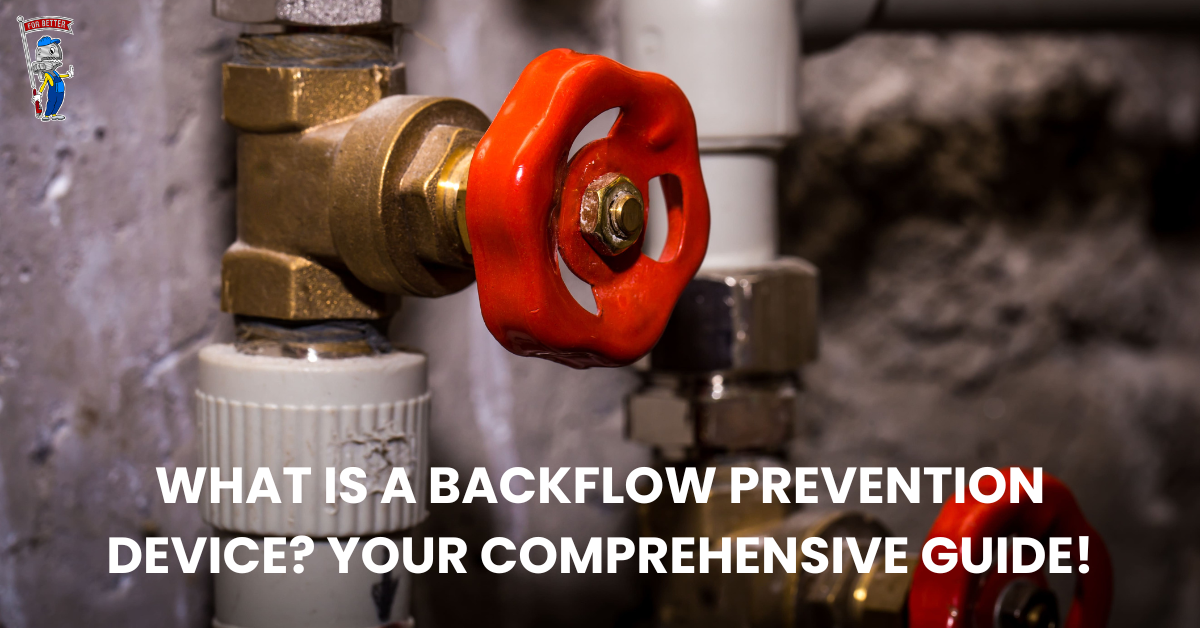Welcome to an in-depth exploration of backflow prevention devices—essential components in maintaining water safety and quality. In this comprehensive guide, we’ll unravel the mysteries surrounding these devices, covering what they are, the types available, their significance, their applications, and how to ensure their effectiveness.
What is a Backflow Prevention Device
At its core, a backflow prevention device is a safeguard against the unwanted reversal of water flow within plumbing systems. This critical component prevents contaminants from entering the clean water supply, ensuring the water remains safe for consumption.
Types of Backflow Prevention Devices
1.) Dual Check Valves
Dual-check valves, also known as double-check valves, are commonly used in residential and commercial settings. They feature two independently operating check valves, providing an extra layer of protection against backflow.
2.) Atmospheric Vacuum Breakers (AVBs)
AVBs are suitable for applications with non-health hazard conditions. They operate by allowing air to enter the plumbing system, preventing the backflow of contaminated water.
3.) Pressure Vacuum Breakers (PVBs)
PVBs are employed in higher-risk situations, such as irrigation systems. These devices create a barrier against backflow by using a spring-loaded check valve and an air relief valve.
4.) Reduced Pressure Zone Devices (RPZDs)
RPZDs are highly effective in preventing backflow in high-risk areas, such as industrial facilities. They consist of two check valves and a relief valve, creating a reliable barrier against contamination.
5.) Spill-Resistant Pressure Vacuum Breakers
These devices incorporate an air inlet that is spill-resistant, providing an additional layer of protection in case of a water spillage event.
6.) Double Check Detector Assemblies (DCDAs)
DCDAs include a double-check valve assembly with an added detector for monitoring purposes. These devices are suitable for applications where continuous monitoring is essential.
7.) Hose Connection Vacuum Breakers (HCVBs)
Specifically designed for hose bibs and outdoor faucets, HCVBs prevent backflow in low-risk scenarios. They are a cost-effective solution for residential outdoor water outlets.
Mechanism of Backflow Prevention Devices
Backflow prevention devices operate on various principles, all aimed at ensuring the unidirectional flow of water and preventing contaminants from entering the clean water supply.
What is the purpose of backflow prevention devices?
1.) Safeguarding Water Quality
The primary use of a backflow prevention device is to safeguard water quality. In various settings, such as residential homes, commercial establishments, and industrial facilities, these devices act as critical barriers against the infiltration of contaminants.
2.) Preventing Contamination
Backflow prevention devices play a pivotal role in preventing contamination of the potable water supply. They ensure that water intended for consumption, cooking, and other domestic or industrial uses remains free from harmful substances.
3.) Meeting Regulatory Standards
In many regions, regulatory standards mandate the installation of backflow prevention devices. Compliance with these standards is essential to ensure that water systems align with health and safety regulations, guaranteeing the well-being of the community.
4.) Protecting Public Health
By preventing backflow and maintaining the integrity of the water supply, these devices contribute directly to protecting public health. Contaminated water can harbor bacteria, chemicals, or other pollutants that pose severe health risks when consumed.
5.) Preserving Water Safety
Whether in a residential setting or an industrial complex, backflow prevention devices play a crucial role in preserving water safety. They act as a line of defense, ensuring that water remains a reliable resource for various purposes without compromising safety.
How do I know if I have a Backflow Prevention Device?
Identifying the presence of a backflow prevention device involves a combination of visual inspection and knowledge about the plumbing system. Here are key indicators that you may have a backflow prevention device:
Check Your Water Meter Setup
Inspect your water meter setup. If there is a device attached, resembling a valve or additional apparatus, it might be a backflow prevention device. These devices are often installed near the water meter to protect the public water supply.
Examine Your Plumbing System
Review your plumbing system, especially near points where the main water line enters your property. Backflow prevention devices are commonly installed at these entry points to safeguard against contamination.
Consult Your Water Provider
Reach out to your water provider or utility company. They can provide information about the type of backflow prevention devices in use and whether your property is equipped with one.
Look for External Devices
External devices, such as atmospheric vacuum breakers or pressure vacuum breakers, may be visible on outdoor faucets or irrigation systems. These devices serve specific purposes in preventing backflow in different scenarios.
Examine Plumbing Records
Check any plumbing records or documentation you have for your property. Previous installations or upgrades may be documented, providing insights into the presence of backflow prevention measures.
Why Identifying Backflow Prevention Devices Matters
Ensuring Water Safety
Identifying backflow prevention devices is crucial for ensuring water safety. These devices act as barriers against contaminants, preventing them from entering the main water supply and compromising the health of individuals consuming the water.
Compliance with Regulations
Many regions have strict regulations regarding the installation of backflow prevention devices. Identifying and maintaining these devices ensures compliance with local health and safety standards, preventing legal complications.
Protecting Public Health
The presence of a backflow prevention device directly contributes to protecting public health. By preventing the contamination of water, these devices mitigate the risk of waterborne diseases and other health hazards.
Frequently Asked Questions
Do I need a backflow prevention device at home?
The necessity of a backflow prevention device at home depends on local regulations and the potential health hazards in your area. It’s advisable to check with your water provider or a plumbing professional to determine if one is required for your property.
Can I install a backflow prevention device myself?
While some outdoor devices may be suitable for DIY installation, most backflow prevention devices, especially those protecting the main water supply, should be installed by a licensed plumber. Professional installation ensures compliance with regulations and the effectiveness of the device.
If you’re unsure about backflow prevention requirements or need assistance with installation, we’re here to help. Contact us today, and our team of experts can guide you through the process and ensure your system meets all necessary standards. Don’t compromise the safety of your water supply.
How often should I test my backflow prevention device?
Testing frequency depends on local regulations and the type of device installed. Generally, annual testing is recommended to ensure the device functions correctly. Consult with a licensed plumber to determine the appropriate testing schedule for your specific device.
What are the potential consequences of not having a backflow prevention device?
Without a backflow prevention device, there’s an increased risk of water contamination, posing health hazards to individuals consuming the water. Additionally, non-compliance with local regulations may result in legal consequences.
Can backflow prevention devices be installed in existing plumbing systems?
Yes, backflow prevention devices can be retrofitted into existing plumbing systems. A licensed plumber can assess your current setup and recommend suitable devices to enhance water safety.
Are there any maintenance requirements for backflow prevention devices?
Regular maintenance is essential to ensure the ongoing effectiveness of backflow prevention devices. This may include inspections, testing, and potential repairs. Consult with a licensed plumber for specific maintenance guidelines.
Can backflow prevention devices be recycled?
In some cases, components of backflow prevention devices may be recyclable. However, due to the specialized nature of these devices, it’s advisable to consult with local recycling facilities or waste management authorities to determine the appropriate disposal methods.
How often should I test my backflow prevention device?
Testing frequency depends on local regulations and the type of device installed. Generally, annual testing is recommended to ensure the device functions correctly. Consult with a licensed plumber to determine the appropriate testing schedule for your specific device.
Secure Your Water Supply with Expert Backflow Services
When it comes to backflow prevention, it’s not just about complying with regulations; it’s about protecting the health and well-being of your community. Our services begin with thorough compliance assessments, where we carefully examine your existing system to identify potential risks and vulnerabilities.
Our licensed plumbers are trained to handle the installation of backflow prevention devices, especially those crucial to safeguarding the main water supply. We prioritize precision and compliance to guarantee the effectiveness of the devices in preventing the unwanted reversal of water flow.
Beyond installation, our team offers ongoing maintenance and inspection services to keep your backflow prevention system in top-notch condition. Regular checks ensure that your system continues to meet all regulatory standards, giving you peace of mind regarding the safety of your water supply.
Ensure the integrity of your water supply by relying on our professional backflow services. From compliance assessments to licensed plumber installations, we’ve got you covered. Don’t leave the safety of your water system to chance—contact us today for comprehensive backflow solutions. Our team of experts is ready to assist you in meeting all regulatory requirements and safeguarding your water quality. Your peace of mind is just a call away.



